Oct 12, 2005
Sensory threads
Sensory Threads aims to stimulate and inform a public debate on how personal biosensor data is collected and used in biomedical science. It will combine an artistic with an evidence-based approach, building and testing a prototype body biosensor network that uploads data to Urban Tapestries.

This will allow participants to map experiential and emotional annotations to their readings – adding a whole new layer of sentient knowledge to machine data. It is intended to demystify how data is collected, what it produces and how we can correlate it to other factors affecting health such as environmental pollution.
Principal Investigators: Giles Lane (Proboscis) & George Roussos (Birkbeck)
Team: Alice Angus, Orlagh Woods, Sarah Thelwall, George Papamarkos, Dikaios Papadogkonas
Partners: Proboscis, Birkbeck College Computer Science Dept.
15:25 Posted in Cyberart | Permalink | Comments (0) | Tags: Positive Technology
Dimensionality explores new dimensions of space
Dimensionality takes assumptions of perspective is coming to an end, or mutating under new environmental pressures—video games, computer animation, 3-D computer models as its generative trope. Curator, Andy Patton has assembled a group of artists whose specific practices address the new spaces of digital realities. The works in the exhibition are often diagrammatic and stripped of worldly detail.  They declare an involvement with information instead of sensuous phenomena. The participating artists don’t produce the sort of naturalist space we've seen for the last few centuries, rather, their space is structured like that of video games—a space that’s only convincing if it streams rapidly by, before its too-generalized surfaces can be inspected. deep and convincing, as though you could walk into it. As Patton states, "Star Trek was wrong: space is the initial frontier"
They declare an involvement with information instead of sensuous phenomena. The participating artists don’t produce the sort of naturalist space we've seen for the last few centuries, rather, their space is structured like that of video games—a space that’s only convincing if it streams rapidly by, before its too-generalized surfaces can be inspected. deep and convincing, as though you could walk into it. As Patton states, "Star Trek was wrong: space is the initial frontier"
Featuring: Sheila Ayearst, Robert Fones, Morna Gamblin, Nestor Kruger, Angela Leach, Kristen Peterson, David Reed
Starts: Sep 10, 2005 Ends: Oct 22, 2005
At: YYZ Artists' Outlet, 401 Richmond Street West, Suite 140, Toronto
Times: 11:00 AM - 5:00 PM
Cost: Free
15:10 Posted in Cyberart | Permalink | Comments (0) | Tags: Positive Technology
Sep 23, 2005
Media Fabrics
Interactive Cinema - Media Fabrics is a research initiative at MIT that focuses on a new paradigm: the "media fabric" - a semi-intelligent organism where lines of communication, 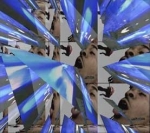 threads of meaning, chains of causality, and streams of consciousness converge and intertwine to form a rich tapestry of creative story potentials, meaningful real-time dialogues, social interactions, and personal or communal art- and story-making.
threads of meaning, chains of causality, and streams of consciousness converge and intertwine to form a rich tapestry of creative story potentials, meaningful real-time dialogues, social interactions, and personal or communal art- and story-making.
More to explore
The Media Fabrics website
13:35 Posted in Cyberart | Permalink | Comments (0) | Tags: Positive Technology, cyberart
Sep 21, 2005
Brainmirror
Via dataisnature
BrainMirror is an interactive experience where the image of the visitors brain appears mixed with his/her mirror image, using natural head movement as an interface to explore volumetric visuals of the human brain. 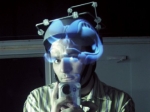 How it works? a motion tracker computer watches the audience through four fire-wire cameras equipped with infra-red filters. The helmets are mounted with super-bright infra-red LED's, each modulating it's brightness with it's own unique finger-print id-code.
How it works? a motion tracker computer watches the audience through four fire-wire cameras equipped with infra-red filters. The helmets are mounted with super-bright infra-red LED's, each modulating it's brightness with it's own unique finger-print id-code.
Download video (32Mb Quicktime)
15:41 Posted in Cyberart | Permalink | Comments (0) | Tags: Positive Technology
Aug 03, 2005
Tim Hawkinson's presence-evoking art
Via the Presence-L Listserv
By Christopher Knight, Times Staff Writer
For his mid-career survey exhibition at the Los Angeles County Museum of Art, Tim Hawkinson has suspended wires and electrical cords high overhead throughout the capacious ground-floor galleries of the Anderson Building. The wiring is there to provide power for the machinery and computers that operate his often kinetic art. Think of it as a homemade power grid — a replica in miniature of something vast on which we all rely but about which we pay little attention until it's not there. 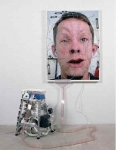 Hawkinson's art is sort of like that too. As a garage band is to a philharmonic orchestra, so Hawkinson's technological tinkering is to science and industry. His art speaks to social experience and human mortality. But part of the work's attraction is the way it peels back its systems of operation like layers of an onion, displaying them for your contemplation.
Hawkinson's art is sort of like that too. As a garage band is to a philharmonic orchestra, so Hawkinson's technological tinkering is to science and industry. His art speaks to social experience and human mortality. But part of the work's attraction is the way it peels back its systems of operation like layers of an onion, displaying them for your contemplation.
Take "Emoter," a self-portrait of the artist as a young cyborg. A cut-up inkjet print showing the artist's face is mounted on a panel of plastic and foam core, which hangs on the wall. Electrodes fastened to the face are connected to mechanical components, mounted like a high school science project on a nearby stepladder. There, light sensors are affixed to a television monitor, and they send random signals in response to the broadcast program.
Walk up to Hawkinson's portrait and, accompanied by soft buzzing and whirring, his face begins to change expressions. Eyebrows rise. Nostrils flare. Lips part. Some expressions are familiar, some freakish.
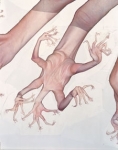 While you're puzzling over the portrait's apparent reaction to your presence in the room, and how the goofy effect is accomplished, it suddenly dawns that grins, a furrowed brow and other bemused expressions are washing over your own face too. Who's the real "emoter" here? Hawkinson or his audience?
While you're puzzling over the portrait's apparent reaction to your presence in the room, and how the goofy effect is accomplished, it suddenly dawns that grins, a furrowed brow and other bemused expressions are washing over your own face too. Who's the real "emoter" here? Hawkinson or his audience?
Who is responding to what — the picture to you or you to the picture? Is the title a pun for e-motor — that is, an electronic motor, which reacts mechanically to outside stimuli? Does the flickering TV tube reside at the heart of this emotional circuitry? How mechanical (or preprogrammed) are our own responses to experience?
"Emoter" also puts you in mind of multi-user computer programs, the kind that run over the Internet and allow multiple users to participate in role-playing games. In virtual reality, "to emote" is to indicate the performance of an action, usually with a facial expression of emotional state. Hawkinson's theatrical self-portrait represents the face of a new world — familiar and freakish, but one we all now inhabit... READ THE FULL ARTICLE
More to explore
Tim Hawkinson's interview and works
Art:21 Film on Tim Hawkinson
Tim Hawkinson essay and images
Tim Hawkinson art books (Amazon)
19:11 Posted in Cyberart | Permalink | Comments (0) | Tags: Positive Technology
Apr 04, 2005
Bianco-Valente: Neurovisions of the post-human age
Contemporary art is exploring the link between mind, brain and technology. Artists are scientists who experiment reality in a different way. They don't use the language of maths and physics, but the universal language of sensory experiences. There are concepts that cannot be expressed using numbers. For example, how would one represent the infinite complexity of the relationship between the mind and the brain? And how to describe the invisible co-evolution between natural and artificial, between biological and technological networks?

Bianco and Valente, two artists working in Neaple (Italy) propose an original answer to these questions. The focus of their work is "on perception phenomenons and brain dynamism that enable us to retain the memories of our experiences and perceive mind images, through which we can conceive an evolving reproduction of the external reality A very fascinating subject for us is the body-mind duality: 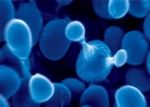 a flesh organic structure, finite and dependent on space and time that carries about the mind, a spontaneous phenomenon without visible boundaries, totally free and self-referential. We search for boundaries of this immaterial space living into the cerebral convolutions, trying to understand if and where it is possible to locate a point of contact linking indivisibly the two domains, the material and the immaterial"
a flesh organic structure, finite and dependent on space and time that carries about the mind, a spontaneous phenomenon without visible boundaries, totally free and self-referential. We search for boundaries of this immaterial space living into the cerebral convolutions, trying to understand if and where it is possible to locate a point of contact linking indivisibly the two domains, the material and the immaterial"

More to explore
Bianco-Valente Web site (only Italian, but with a few English articles about their work)
18:41 Posted in Cyberart | Permalink | Comments (0)
Mar 24, 2005
Animator Makes Waves as Artist
From WIRED
by Rachel Metz
NEW YORK -- If beauty is in the eye of the beholder, oversized heads, alarmingly cherry-red lips, blotchy skin and sharp scroll-like claws are en vogue, at least in the digital world of artist Ray Caesar.
Caesar, a Toronto-based former animator and graphic artist for a children's hospital, is making waves in the world of pop art with his haunting, surreal digital prints, all produced just 18 months after he decided to pursue art full time. His works combine varied aspects of his life experiences, including the sorrow and inspiration brought by deaths of loved ones, and his years spent viewing photos of and working with abused, neglected and deformed children. His prints also benefit from Caesar's expertise with animation software and his exposure to animal research.
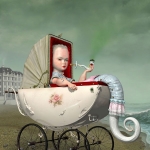
The prints are both grotesque and beautiful. As Caesar explains it, it's like facing something unpleasant with calm and looking beyond what you're viewing to see the beauty within.
Exhibits of Caesar's work are as real as it gets, because his art is created and manipulated digitally on his Dell 8300 computer and then printed on his massive, wide-format Epson 7600 printer. The "original" exists only on Caesar's hard drive and can be repositioned and changed at his whim. He uses the animation program Maya to compose his pieces.
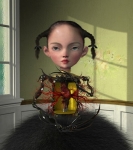
A selection of Caesar's works were presented Saturday March 19, at the evening opening of his latest show, Hidden Doors and Secret Rooms, at the Jonathan LeVine Gallery in New York City's Chelsea neighborhood.
The show, which runs through April 18, had an impressive opening for an artist so new to his field. Throngs of curious visitors milled around, chatting and viewing pieces showcasing Caesar's signature haunted style.
To craft his prints, Caesar makes a digital doll model with an invisible inner skeleton. He can then pose the dolls or refine parts of their skeletons.
He embellishes the blank models with clothing he builds in Maya. At home in Toronto, Caesar visits a textile warehouse where he borrows swatches or buys yards of fabrics that strike his fancy. He then photographs the cloth and manipulates it in Photoshop.
Similarly, Caesar collects skin images he shoots with a digital camera and then maneuvers them in Photoshop before applying the images as a model's epidermis.
Furniture designs are inspired by things like antiques, Richie Rich comics, and items that surrounded him in his childhood homes, first in England and later in Canada, he said.
Because of the way his pieces come together, "I kind of feel like I'm doing reverse animation," Caesar said, later explaining, "There's so much movement, and yet in I'm ending up with a still image."
Besides movement, Caesar is a fan of digital recycling -- anything he can reuse, he does, he said, like elements of an image of an airplane, sewing machine or distant building. He's also big on detail, as is evident in intricate tattoos, tiny table-top knickknacks and seemingly 3-D textures of subjects' dresses.
READ FULL ARTICLE
About the artist
Information about Ray Caesar can be found on the artist's official web site
12:50 Posted in Cyberart | Permalink | Comments (0)
Feb 10, 2005
Cyberart Festival
The Boston Cyberarts Festival is an international biennial festival of art and technology in all media. The next Festival will take place April 22 through May 8, 2005. It will include visual and performing arts and explore how artists throughout the world are using computers to advance traditional artistic disciplines and create new interactive worlds.
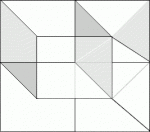
The 2005 Festival will also feature two conferences during the opening weekend: eMerging Arts and Technologies, for artists and high-tech company professionals; and Ideas in Motion, focused on innovations in dance, movement, and technology.
13:46 Posted in Cyberart | Permalink | Comments (0)
Speaking with objects
The art and soul of a new machine
by Missy Sullivan, Forbes Magazine, 09.20.99
Did you ever notice how a chicken wishbone, turned upside down, looks remarkably like a bowlegged cowboy in chaps? Ever imagine a cloud gliding down from the sky bearing gifts? C'mon, admit it. In some idiotic moment of utter boredom you have fantasized about blowing something up.
For most people, these are idle thoughts. But reveries like these are what inspired sculptor, inventor and award-winning toy designer Arthur Ganson, 44, to create his wondrous machines.
He had that wishbone epiphany. It's embodied in a clattering contraption of wires, gears and pulleys that makes a chicken wishbone swagger like a miniature John Wayne. The cloud fantasy? On their first anniversary his wife looked up to see a tray of chocolate and sake descending on a mechanical cloud that he was diligently lowering from the ceiling.

You can see the outcome of Ganson's big-kaboom dream for yourself on your next trip to Boston. Just head over to his exhibition at the Massachusetts Institute of Technology Museum--he's an artist-in-residence at the school--where a wildly popular machine repeatedly blows up and reconfigures a miniature yellow chair.
These are just a few of the fantastical creations from Ganson's studio outside of Boston. Frank Maresca, co-owner of the Ricco/Maresca Gallery in New York (where a Ganson sculpture goes for between $15,000 and $60,000), describes the studio as a cross between Santa's workshop and mission control for the moon launch.

This helps explain why Ganson has something of a cult following among local college students, some of whom return to the MIT exhibit 40 to 50 times. A comment in the visitors book from an even younger fan: "You're either a psycho or a genius, or both. Either way, you rule!"
But Ganson's machines are a lot more than just clever gadgets. The art part comes in the way his mechanical gestures so intuitively and eloquently convey human feelings. Wriggling inchworms, mincing feather dusters, Kabuki-dancing miniature plastic swords. Ganson's work celebrates life with a sense of wonderment and humor that's all too rare in the self-important world of contemporary art.
You can see it in the reactions to Ganson's work up at MIT. Eyes widen in front of torn-paper "wings" fluttering poignantly atop a forest of thin wire poles. And people actually blush before the machine that erotically spurts grease on itself.
One recent work, "Machine with Artichoke Petal," stands a dried-up little leaf atop a wheel, its curled tip perfectly evoking a dejected head. Set the wheel in motion and the schlumpy little guy starts trudging slowly along like Willy Loman after a bad sales day.
"It's astounding to me that someone can make a machine with such nuanced and complex emotional resonances," says Nicholas Capasso, curator of Ganson's first one-person museum show in 1993 at the DeCordova Museum & Sculpture Park in Lincoln, Mass. "Anyone can make a machine that waves, but only Arthur can make a machine that waves good-bye. There's a big difference."
About the artist
Arthur Ganson has been making kinetic sculpture for 27 years, having received a BFA from the University of New Hampshire in 1978. He has exhibited his machines in galleries and museums in the United States and Europe. A former artist-in-residence at the Massachusetts Institute of Technology, he maintains an ongoing exhibition of sculpture at the MIT Museum in Cambridge. Recently he appeared as a cartoon bear on the animated children's series "Arthur," and his friends say the likeness is remarkable. Ganson is the inventor of the award-winning children's toy Toobers and Zots. He lives and works near Boston. More work may be seen at his Web site, www.arthurganson.com.
13:38 Posted in Cyberart | Permalink | Comments (0)
Jan 04, 2005
Experience Colors!
Art | Color becomes all in Arcadia installation
By Edward J. Sozanski
Inquirer Columnist
Olafur Eliasson's installation at Arcadia University, Your colour
memory, might be the most intense and disorienting sensory
experience you'll ever have.
Being inside this oval space suffused with the most vivid color
imaginable, shifting at random through every hue of the spectrum
and then some, is like standing inside a sunrise.
The installation that transforms the Arcadia gallery into a color-
immersion chamber is complex technically, but easily described.

Inside the rectangular, high-ceilinged room, Eliasson has
constructed an oval, open-topped chamber with a small chamber
at one side that's curtained off.
One enters at the side, at a point where the encircling wall
separates like the first coil of a spiral. The inside surface of the
oval is made of translucent plastic stretched as taut as a
drumhead.
Inside the wall, whose outside surface is opaque, Eliasson has
installed a series of computer-controlled lights and filters. These
lights generate random sequences of primary and secondary
colors that change unpredictably.

To say that the light in this chromatic bombardment is intense
understates the effect, which admittedly varies for each visitor.
We all see and react to colors differently, but I doubt anyone with
normal color vision would deny that Eliasson's installation
transforms color into a physical presence.
19:10 Posted in Cyberart | Permalink | Comments (0)






